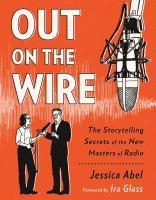
Writers of fiction generally look to other writers of fiction for advice and inspiration. Memoirists to other memoirists. Poets to poets. It just makes sense, that to learn your craft better you seek someone who has mastered it.
But there are times when mastery advice transfers. When it's not so much about form as the basic ability to convey ideas and relate feelings, regardless the style or medium. On a certain level, all of it is about becoming a master storyteller.
I tell stories. That's what I do for a living. I'm betting you do, too. . . . We are all storytellers.
So what do these radio producers know that I don't? Because, the question is, How do they make these stories solid gold?
That's the burning question Jessica Abel followed that led to the creation of her book Out on the Wire: The Storytelling Secrets of the New Masters of Radio. It is a documentary graphic novel about the making of documentary radio stories. And it is a story about storytelling.
The question emerged from her interest as a fan, from which emerged the following conviction:
Radio, especially public radio and the podcasts that have sprung from it, and especially (though not exclusively) in the USA, is the most fertile ground for narrative non-fiction in English-language media.
Abel spent two years conducting interviews and shadowing behind-the-scenes events with the producers of This American Life, The Moth, Radiolab, Planet Money, Snap Judgment, Serial, Invisibilia, and other narrative radio shows. Then she figured out how to weave all of that material into a compelling, personal narrative she could illustrate. She, Ira Glass, and other subjects talk to her, to each other, and to readers in turn. They talk about who they are as artists and the processes they follow to create their art.
The material is woven into themes that speak to anyone interested in stories and storytelling.
It's obvious at this point: there are multiple ways to tell all kinds of stories. And so I've been talking to all these radio producers, trying to learn what they know. These shows differ. They reflect the truth of what they are: the work of individuals, each following his or her own curiosity. But they have certain elements in common that just jump out.
- Stories that ask big questions.
- Surprising, engaging characters.
- Authentic voices.
- Robust narrative structure.
- In many case, intricate uses of sound as part of storytelling.
- And the people making these stories get there in a characteristic way: through intense collaboration where everyone gives and receives honest feedback.
These shows have something universal to say about narrative. You can use these ideas to tell stories effectively, in comics, in film, in journalism . . . These things work. When people craft stories with these elements, the voices we hear are powerful. When they say, "Listen, let me tell you a story . . . " you can't help but listen.
So listen. Let me tell you a story.
Abel's subtitle may call these things "secrets," though simply listing them isn't particularly revealing. The journey through them, however, as presented in Abel's book, certainly is. This is a fascinating, engaging, informative meditation on story creation helpful for all types of storytellers.
It even helped her:
Turns out, I need to read this book in order to write it.
In the end, that's kind of what happened. I wrote the book and read it, rewrote and read it, and drew it and read it . . . and finally found my way out of [unproductive writing frustration] by following a path carved out before me by all the great radio artists I interviewed.
It's a path that all of us can use to create the stories we want to tell . . . and that everyone else can't wait to hear.
